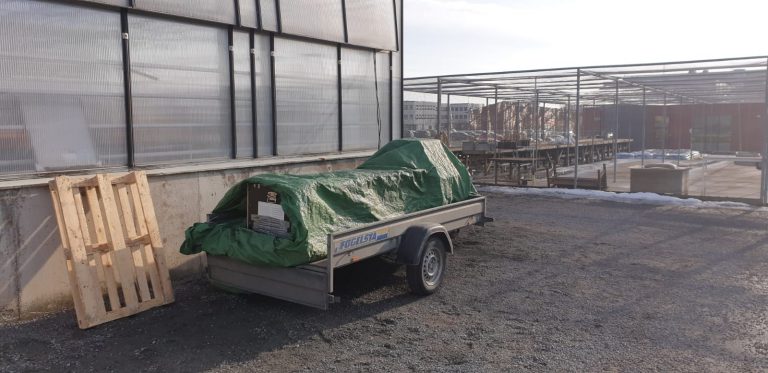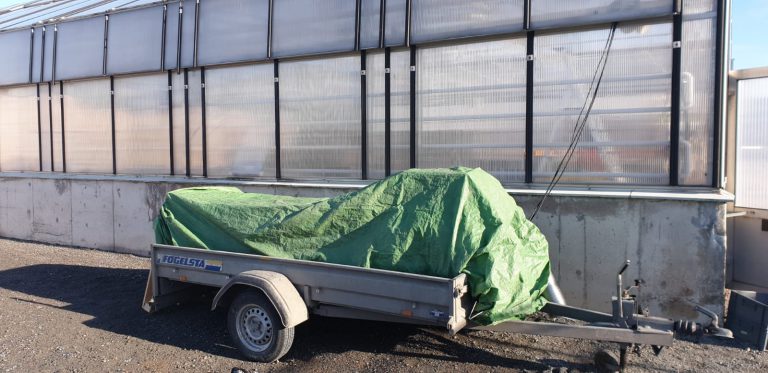We are looking for a motivated and enthusiastic student to assist in developing a computer model that simulates the impacts of different technology choices for management of wastewater flows. The model will be incorporated into a serious game that we are developing to guide sanitation planners and decision-makers. The game is a multi-stakeholder, spatial planning game for municipal sanitation which focuses on resource recovery. It will allow for a visual representation of what technologies can be used and what resources can be recovered from sanitation facilities.
Category: English
Project opportunity: Life cycle assessment of large scale fly larvae composting in Swedish conditions
 Photo: Viktoria Wiklicky
Photo: Viktoria Wiklicky
Titel: Livscykelanalys av fluglarvskompostering under storskaliga svenska förhållanden
Title:Life Cycle Assessment of Large Scale Fly Larvae Composting in Swedish Conditions
Credits: 30 credits
Level: Advanced
Subject: Technology or environmental science
Start: As soon as possible
Kristina Lundgren, M.Sc. thesis on pretreatments in BSF composting
Just at the end of January, Kristina Lundgren presented her master thesis at Uppsala University. The aim of the thesis was to increase the understanding of how bacteria may affect fly larvae composting with the black soldier fly. The results showed no significant impact on the survival, final biomass or reduction of substrate when bacteria isolated from BSF eggs where inoculated into the substrate (food waste). However, interestingly the variation in resulting biomass and material reduction was decreased when any bacteria or group of bacteria were added to the food waste. Hence, the system became easier to predict, which especially is desirable when scaling up the system. The audience seemed intrigued by fly larvae composting as a waste management tool and had questions both regarding large scale facilities and the possibility that inoculation bacteria might yield positive effects in other substrates.
The urine drying pilot is operational
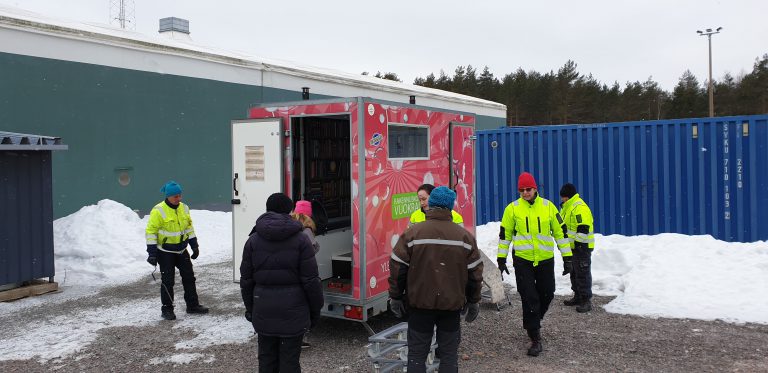
Setting up the toilet at our test site and final touches
After a week in the city of Tampere in Finland, our team over there finished integrating a urine drying bed into the Biomaja toilet. The entire toilet is on a trailer, making it portable and houses a dry urinal and a urine diverting dry toilet. The urine treatment is done by alkaline dehydration, a technology developed by our research group and which we have been pursuing for several years now. The urine treatment unit requires an area of just 0.75 m2 and has a capacity of processing 30 L urine/day into a dry, nutrient-rich fertiliser.
On the 4th of March, members of our group that travelled to Finland, along with partners from the MORTTI project transported the integrated toilet 100 km west of Tampere. The toilet is now very much operational, and is intended to be used for a period of at least 3 months.
Lovisa Lindberg, M.Sc. Emissions of greenhouse gases and ammonia during fly larvae composting
Every day, greenhouse gases leak out to the atmosphere around the world, which has a negative impact on the climate. These leakages occur, among other things, from poorly managed and unplanned landfills where a lot of the organic waste ends up. What can be done to get something out of value from organic waste and prevent it from ending up in landfills, which would reduce greenhouse gas emissions? The black soldier fly larvae can be used for this purpose as they feed on organic waste and can halve the amount of waste. The larvae can be separated from the treated waste and then be used in animal feed and the treatment residue can be used as an organic fertilizer. The resources in the organic waste need to be reintroduced into the cycle in order to create a sustainable society since the assets of the earth are declining, this by converting waste and using the resources in waste.
Since it is prohibited to feed production animals with animal by-products according to Article 22 (1) (b) of Regulation (EC) No 1774/2002 of the European Parliament and of the Council, the larvae cannot be fed organic waste because the fly is considered to be a production animal. Vegetable substrates, on the other hand, are permitted to feed the larvae, but more knowledge is needed on how the larvae can absorb the difficult nutrients of these substrates. One solution could be to pretreat the substrate, which was investigated in this study where the pretreatments were performed with fungi or with ammonium solution, respectively.
The purpose of this study was to evaluate emissions of greenhouse gases, carbon dioxide, nitrous oxide and methane gas, and ammonia from fly larvae composting and how efficiently fly larvae composting works for the degradation of vegetable substrates. For more detailed information on the subject, read the thesis (in Swedish) or abstract (English), published in Diva.
Sweden to Finland – the urine drying technology travels for pilot testing!
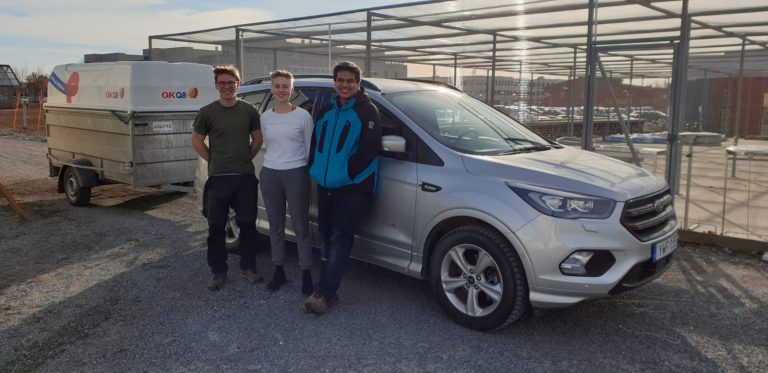
All loaded up and ready to leave! PC: Anooj Ramanathan
On 25th March, three members from our group, Prithvi Simha, Giulio Zorzetto, and Caroline Karlsson headed off to Finland with a trailer full of parts that make up a urine drying treatment system. They arrived after in Finland after an overnight ferry crossing and are currently in the city of Tampere. Here, with the help of our partners in Finland, they will integrate the technology into a mobile toilet that will be operational during the first week of March.
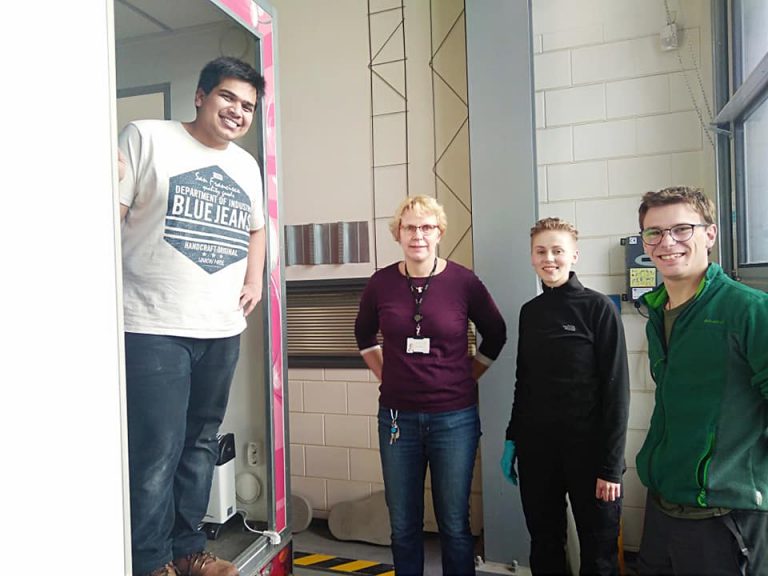
At the Tampere University of Applied Sciences with Eeva–Liisa Viskari . PC: Sari Huuhtanen
Constructing a pilot urine drying system
Since the beginning of this year, the Kretsloppsteknik group has been working towards building a system to pilot the urine drying technology. Several members of the group have been involved in designing, constructing, simulating and testing a system with a capacity to treat 30 L of urine every day in <1 square meters surface area. Over this time, we conducted several experiments, both indoors and outdoors (see picture above). The system is intended to be piloted by integrating it with a portable/mobile toilet that will be installed in Finland during the first week of March to treat 30 L urine/day.
More updates to follow!
Director General of SIDA and the Vice-Chancellor of SLU visited the Greenhouse

Cecilia Lalander from the Environmental Engineering group shows Karin Holmgren, Carin Jämtin and Esse Nilsson the larvae at different stages.

Everyone wanted to feel the heat being generated in the process!
Photo: Malin Planting
On Wednesday (13/2-2019) the Director General of SIDA Carin Jämtin and the Vice-Chancellor of SLU Karin Holmgren honoured us with a visit to our BSF facility. Also on the visit, from SIDA, were Senior Research Advisor Eva Ohlsson and Policy Advisor Esse Nilsson, and from SLU Pro Vice-Chancellor, international relations Ylva Hillbur, Head of SLU Global Sara Gräslund and communicator Malin Planting.
During the visit we demonstrated the concept of turning waste into value by converting it into larval biomass that can be used as animal feed. We in the group were pleasantly surprised by the enthusiasm with which the visitors put their hands into the fly larvae compost in order to feel the heat being generated in the degradation process and the movement of the larvae.

The visit finished with a group photo
Nils Ewald, M.Sc. thesis on fatty acid composition of BSF larvae
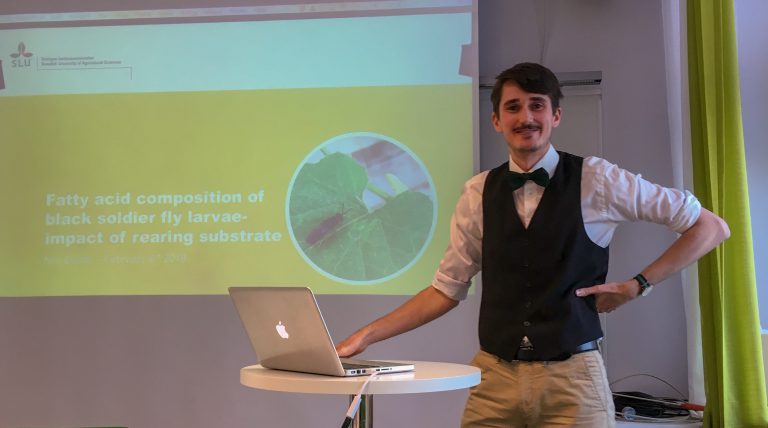
After almost half a year of work, Nils Ewald presented his master’s thesis last week for the audience at the Department of Molecular Sciences. In the thesis he investigated the relation between the fatty acid composition of the Black soldier fly larvae, and the different waste materials that were fed to the larvae. From the work it was found that the larvae contains a high proportion of saturated fatty acids, but that the growth of the larvae, as well as the fatty acid composition of the substrate, affects the fatty acid profile of the larvae. Since Black soldier fly larvae was a new topic for many in the audience, there came a lot of curious questions such as: Are the larvae safe to use? What are the ethical aspects of producing insects?
There is still a lot we don’t know about the Black solider fly, but the only way to find out more is by further investigating the creature. For the future, the hope is that it will be possible to publish the results from the study in a scientific journal.
New Publication Polymers 2019, 11, 287; doi:10.3390/polym11020287
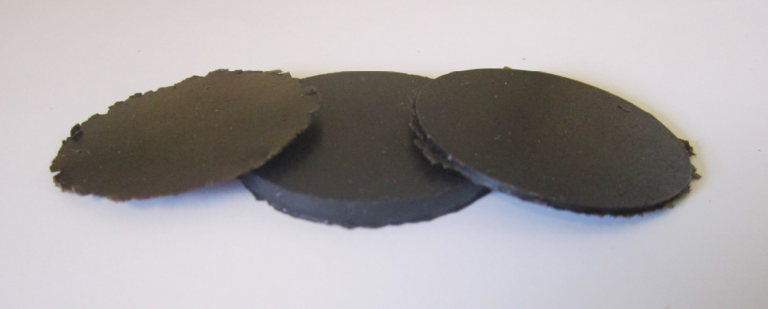
A Protein-Based Material from a New Approach Using Whole Defatted Larvae, and Its Interaction with Moisture
Nazanin Alipour, Björn Vinnerås, Fabrice Gouanvé, Eliane Espuche and Mikael S. Hedenqvist
A protein-based material created from a new approach using whole defatted larvae of the Black Soldier fly is presented. After removing the larva lipid and adding a plasticizer, the ground material was compression molded into plates/films. The lipid, rich in saturated fatty acids, can be used in applications such as lubricants. The amino acids present in the greatest amounts were the essential amino acids aspartic acid/asparagine and glutamic acid/glutamine. Infrared spectroscopy revealed that the protein material had a high amount of strongly hydrogen-bonded β-sheets, indicative of a highly aggregated protein. To assess the moisture–protein material interactions, the moisture uptake was investigated. The moisture uptake followed a BET type III moisture sorption isotherm, which could be fitted to the Guggenheim, Anderson and de Boer (GAB) equation. GAB, in combination with cluster size analysis, revealed that the water clustered in the material already at a low moisture content and the cluster increased in size with increasing relative humidity. The clustering also led to a peak in moisture diffusivity at an intermediate moisture uptake.

